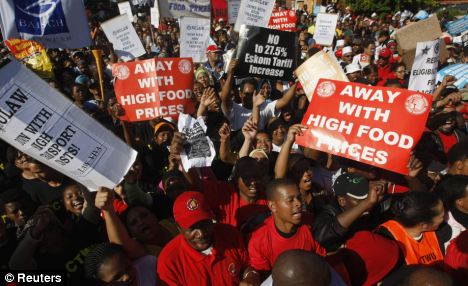Root Cause of Middle East Riots – Hunger
In the NPR column “Can Riots Be Predicted? Experts Watch Food Prices” Maria Godoy reports, “When French peasants stormed the Bastille on July 14, 1789, they weren’t just revolting against the monarchy’s policies. They were also hungry.” [Emphasis Mine]
Washington Post’s Foreign Service corespondent Ariana Eunjung Cha in April 2008 reported, “The price of grains — corn, wheat, and rice — has been rising since 2005 under pressure from farmers who would rather plant crops for bio-fuels than for food, the lack of technological breakthroughs in crop yields, and drought and disease. The sharpest increase has been this year, with the price of Thai rice, a world benchmark, nearly doubling since January, to $760 per metric ton. Some analysts expect that price to reach $1,000 in the next three months.” [Emphasis Mine]
“Despite efforts by governments to increase public-sector wages and introduce food subsidies, price increases and shortages have led to violent clashes along supply lines, in food distribution centers and at supermarkets,” reports Cha. [Emphasis Mine]
Obama administration was warned about the nexus between hunger and riots just prior to the Arab Spring.
According to Godoy Yaneer Bar-Yam of the New England Complex Systems Institute (NECSI) in Cambridge, Massachusetts, “…and his colleagues say they submitted their analysis warning of the risks of social unrest to the U.S. government on Dec. 13, 2010. Four days later, Tunisian fruit and vegetable vendor Mohamed Bouazizi set himself on fire – an event widely seen as the catalyst for the Arab Spring.”
“From the French Revolution to the Arab Spring, high food prices have been cited as a factor behind mass protest movements. But can food prices actually help predict when social unrest is likely to break out?”, asks Godoy. The answer is yes.
According to Bar-Yam the NECSI model offers the potential to forecast future social unrest by identifying “a very well-defined threshold [for food prices] above which food riots break out”. Godoy reports:
The researchers define the riot danger zone in relation to the U.N.’s FAO Food Price Index, which tracks the monthly change in international prices for a basket of cereals, dairy, meat, sugars and oil/fats. Riots become more likely, their model showed, when the index goes above 210. The index has been hovering above that “disruption threshold” since July, pushed upward by the drought in the U.S., the world’s biggest exporter of corn and wheat.
Wheat is now at $9 per bushel — higher than the high of $8.94 hit in February 2011, when the Arab Spring was in full swing. Corn is at $7.56 a bushel, close to the $7.65 highs of 2007-2008 — though it spiked well above $8 a bushel this summer. The Mideast is particularly sensitive to wheat prices; it imports most of its wheat, which is a major staple for the region.

David W. Kreutzer, Ph.D. writes, “The ethanol mandate in the federal Renewable Fuel Standard increases corn prices and food prices. This harms consumers and distorts the domestic and international commodity market. While waiving the mandate would be an improvement, eliminating it is the best choice.”
Florida’s legislature unsuccessfully tried to introduce legislation to take the state off of the federal ethanol standard. The legislation died in December 2011 in the Florida Senate Commerce and Tourism Committee committee chaired by Senator Nancy Detert. The 2008 law that would be repealed by the bill, backed by then-Gov. Charlie Crist, requires gasoline to include 9 to 10 percent ethanol.
According to the Florida Times-Union Jacksonville, “The sponsor of a measure that would repeal a law requiring ethanol in Florida gasoline agreed to postpone its consideration Wednesday in the Senate Commerce and Tourism Committee, with several members of the panel saying they’re uncomfortable with a full repeal, though there’s support for making sure non-ethanol gasoline is available.” Detert said, “I just don’t want to hurt the businesses that are in place to offer us renewable energy ideas.”
The U.S. Energy Information Administration reports that “Geologists believe there may be large oil and gas deposits in the Federal Outer Continental Shelf in the Eastern Gulf of Mexico, off of Florida’s western coast.”
Perhaps Senator Detert and the Florida legislature should look at how using food for fuel is causing riots in the Middle East and elsewhere? Perhaps it is time for Florida to tap into the oil and natural gas deposits off of Florida’s shore line?
SOME FACTS:
According to UNICEF and the World Health Organization every year six million children die from malnutrition before their fifth birthday. This equates to 16,438 children a day.
The World Health Organization estimates that one-third of the world is well-fed, one-third is under-fed one-third is starving.
Since you’ve entered this site at least 200 people have died of starvation.
Every 3.6 seconds someone dies of hunger.


